AMD Kaveri Review: A8-7600 and A10-7850K Tested
by Ian Cutress & Rahul Garg on January 14, 2014 8:00 AM ESTIntegrated GPU Performance: BioShock Infinite
The first benchmark in our test is Bioshock Infinite, Zero Punctuation’s Game of the Year for 2013. Bioshock Infinite uses the Unreal Engine 3, and is designed to scale with both cores and graphical prowess. We test the benchmark using the Adrenaline benchmark tool and their three default settings of Performance (1280x1024, Low), Quality (1680x1050, Medium/High) and Xtreme (1920x1080, Maximum) noting down the average frame rates and the minimum frame rates.
Bioshock Infinite, Performance Settings
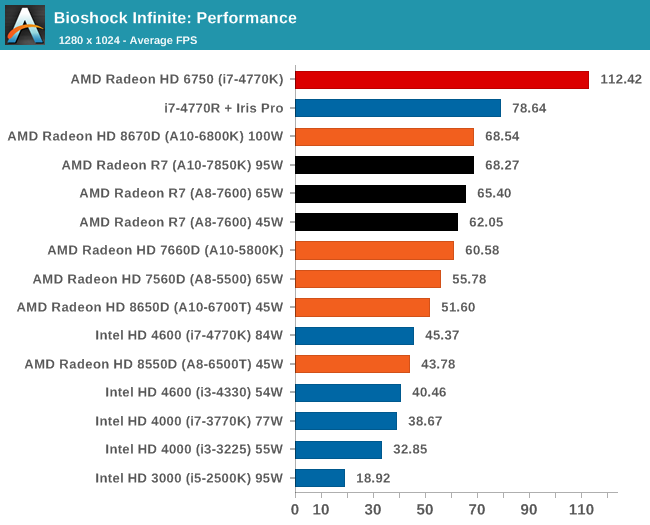
For BI: Performance we see the Iris Pro being top of the IGPs, although the next six in the list are all AMD. The Kaveri cores are all between the 6800K and 5800K for this test, and all comfortably above 60 FPS average.
Bioshock Infinite, Quality Settings

For the quality settings, the Iris Pro starts to struggle and all the R7 based Kaveri APUs jump ahead of the A10-6800K - the top two over the Iris Pro as well.
Bioshock Infinite, Xtreme Settings
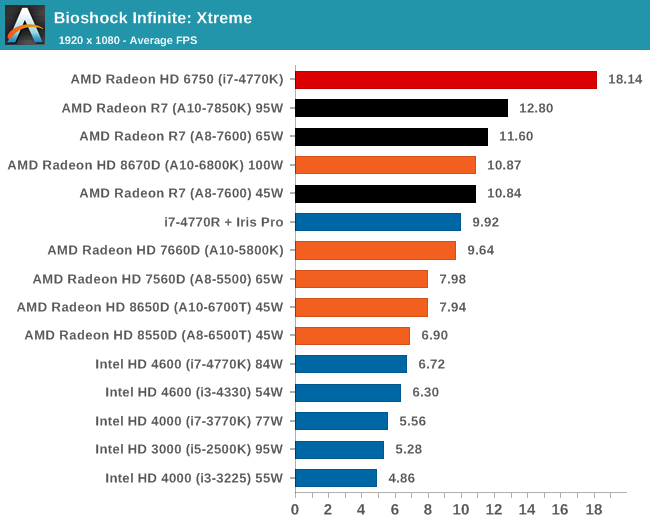
The bigger the resolution, the more the Iris Pro suffers, and Kaveri takes three out of the top four IGP results.
Integrated GPU Performance: Tomb Raider
The second benchmark in our test is Tomb Raider. Tomb Raider is an AMD optimized game, lauded for its use of TressFX creating dynamic hair to increase the immersion in game. Tomb Raider uses a modified version of the Crystal Engine, and enjoys raw horsepower. We test the benchmark using the Adrenaline benchmark tool and their three default settings of Performance (1280x1024, Low), Quality (1680x1050, Medium/High) and Xtreme (1920x1080, Maximum) noting down the average frame rates and the minimum frame rates.
Tomb Raider, Performance Settings
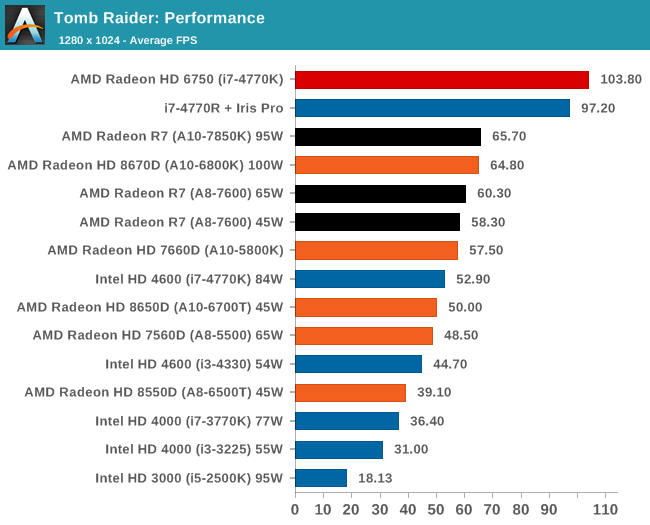
The top IGP for Richland and Kaveri are trading blows in TR.
Tomb Raider, Quality Settings

The Iris Pro takes a small lead, while the Kaveri 95W APU show little improvement over Richland. The 45W APU however is pushing ahead.
Tomb Raider, Xtreme Settings
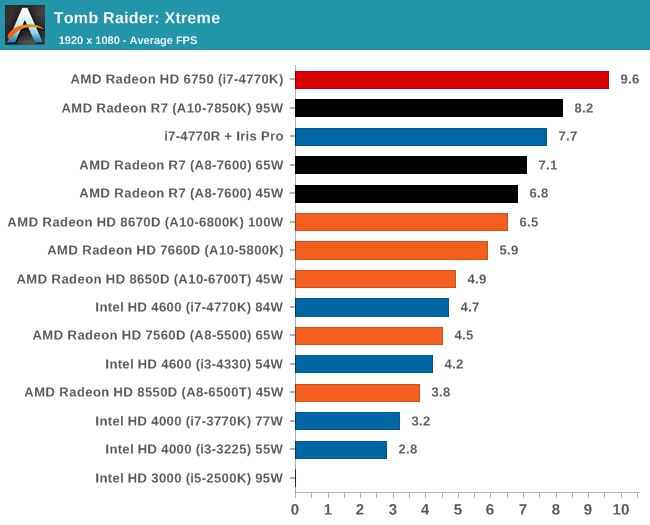
At the maximum resolution, the top Kaveri overtakes Iris Pro, and the 45W Kaveri it still a good margin ahead of the A10-6700T.
Integrated GPU Performance: F1 2013
Next up is F1 2013 by Codemasters. I am a big Formula 1 fan in my spare time, and nothing makes me happier than carving up the field in a Caterham, waving to the Red Bulls as I drive by (because I play on easy and take shortcuts). F1 2013 uses the EGO Engine, and like other Codemasters games ends up being very playable on old hardware quite easily. In order to beef up the benchmark a bit, we devised the following scenario for the benchmark mode: one lap of Spa-Francorchamps in the heavy wet, the benchmark follows Jenson Button in the McLaren who starts on the grid in 22nd place, with the field made up of 11 Williams cars, 5 Marussia and 5 Caterham in that order. This puts emphasis on the CPU to handle the AI in the wet, and allows for a good amount of overtaking during the automated benchmark. We test at three different levels again: 1280x1024 on Low, 1680x1050 on Medium and 1920x1080 on Ultra. Unfortunately due to various circumstances we do not have Iris Pro data for F1 2013.
F1 2013, Performance Settings
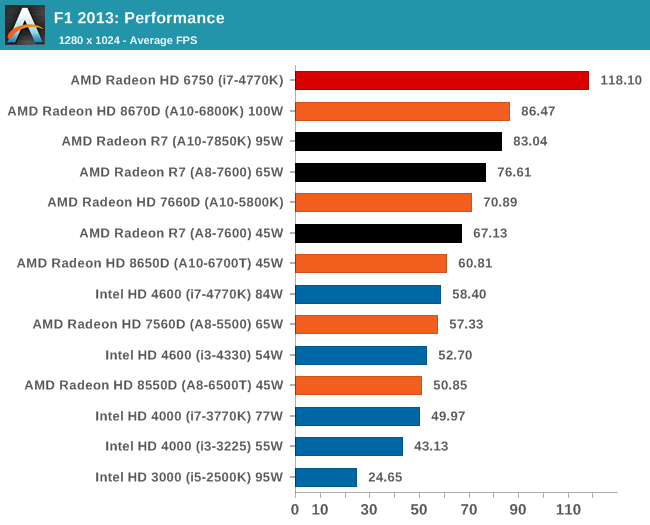
F1 likes AMD here, although moving from Kaveri to Richland at the high end seems a bit of a regression.
F1 2013, Quality Settings
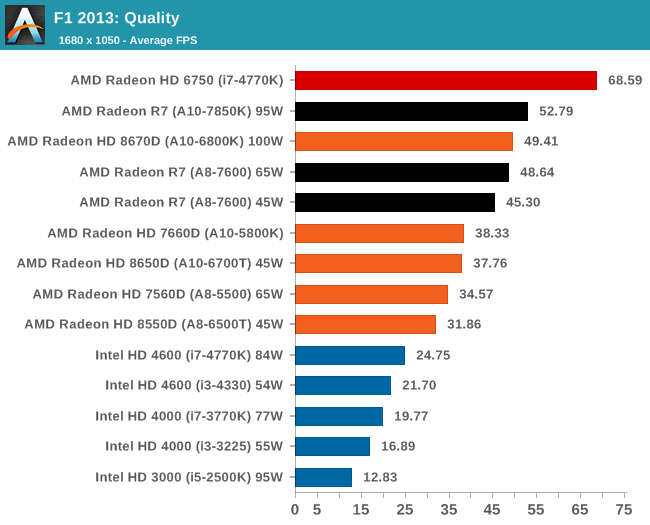
Similarly in the Quality settings, none of the Intel integrated graphics solutions can keep up with AMD, especially Kaveri.
F1 2013, Xtreme Settings

On extreme settings, at 1080p, the top Kaveri APU manages to hit over 30 FPS average during the benchmark. The other A8 Kaveri data is not too far behind.










380 Comments
View All Comments
Fox5 - Wednesday, January 15, 2014 - link
There's also the issue of the Iris Pro's 128MB edram. At a certain point, it probably is insufficient for the settings and resolution.BSMonitor - Wednesday, January 15, 2014 - link
Power consumption numbers?? Interesting to see what adding that many transistors (particularly 128 GPU cores did to those)Da W - Wednesday, January 15, 2014 - link
242 comments so far. Whatever people say, AMD still interests a lot of people and they have a future ahead of them.thomascheng - Wednesday, January 15, 2014 - link
Lets hope they do well, or we will be stuck with buying $1000 Intel CPUs and Nvidia GPUs.TheJian - Wednesday, January 15, 2014 - link
"For casual gaming, AMD is hitting the nail square on the head in its quest for 1080p gaming at 30 frames per second, albeit generally at lower quality settings."Maybe if they'd said for 1280x1024 gaming your comment would be true. Most of the games have mins at 1080p well below 20, and some even avg below 30. This resolution is NOT playable on these crap chips. Buy a vid card and Intel. Period. I really thought these would be faster, but then the downclock due to process happened. Gains in games where you are STILL unplayable isn't a gain. It is a waste of space to benchmark things you can't actually play at. I would rather have seen a dozen games benched at 1280x1024 and a few you KNOW you could run above 30fps at 1680x1050. 1080p here was pointless. AMD should be derided for even mentioning this res with so many games not even playable at avg fps never mind what happens when you click the MIN button in your charts.
Discrete clearly has long legs, as anyone building one of these machines with the new APUs will quickly realize they need to buy discrete to enhance their gaming. I really don't think the dire situation here at 1080p will change until 20nm or more, where you may at that point have MORE games that CAN run 1080p ok, vs what you see here where it's just a joke today.
The games don't even look the same when turning off every feature possible in the game just to hit 30fps. Do you want your games to look like a nintendo 64, or a PC? They should have grown the die a bit for more gpu, so at least 1680x1050 would be pretty good. I don't see AMD making money on cpus for 2yrs :( That means consoles + gpus have to hold the company up and that won't be enough to keep up with R&D in mobile, gpu, cpu. Consoles sold 7mil so far, so at $10-15 per chip ($100 price? per console assuming 15% margin? if they even get that) we're talking about a max of 105mil profits from consoles for the quarter. If they don't keep selling like it's launch month for the next 12 months I see them slowly getting weaker. They owe GF 200mil, so 4 of these console quarters would be ~400mil which is 1/2 blown on GF fines, and the other 200mil goes to interest on their huge debt each year. They need to make some REAL money on cpu/gpu/mobile or this never gets better right? We know cpu is basically out for 2yrs as they say in this article. OUCH. So gpu/mobile has to make something in those two years or this just gets worse and drivers etc will see more phase 1, 2, 3 fixing crap for ages.
The only impressive thing I saw here was Mantle perf claimed by AMD in BF4. But how many times can you afford $8mil to get this done? I'm sure they amped things up for the first time showcase BF4, but how many times can you even afford $2-4mil for this stuff? And then do you get what the dev said in the AMD APU show (only one BTW), a 20% not being unreasonable for your efforts? Far below $8mil for apparently 45% in BF4 right? Devs will opt for the 2weeks to transfer a game to MOBILE first as NV showed can be done with any openGL game (all ps3, ps4 games, many pc games etc) like Serious Sam3 and Trine2 (most of the time according to anandtech was spent on controls, NOT the porting). Unreal 3 engine ported in 4 (yes...FOUR) days by epic/mozilla and it only took 10 people or so. Dice said 2-3 months on mantle. Devs might do 2 weeks just for more sales to a 1.2B unit market on mobile, they will need PAYMENT to do it for Mantle which gets ZERO extra profits (only makes people happy they bought AMD, no extra cash right?). I really hope ARM takes off on desktops, because we currently have an Intel only race and need someone with CASH to fight them. Bring on K1 (and all it's enemies) and all the games for mobile this will create (ported or new, I don't own a ps3 so I'd buy some of those ported that I can't get now). Since we have no real x86 competition any more we need ARM to pick up AMD's slack.
Novaguy - Wednesday, January 15, 2014 - link
Its going to depend on the settings; other reviewers who did 1080p + low to medium settings demonstrated playable frame rates for the a8 but not the intel igps.mikato - Wednesday, January 15, 2014 - link
Ian/Ryan - This seems wrong - "For the 100W APUs at 1280x1024, there is almost no movement between the Richland and the Trinity APUs, except for Company of Heroes" under "IGP Gaming, 1280x1024". In this particular graph, it shows an improvement from Trinity to Richland and then not much improvement from there to Kaveri, except for Company of Heroes.Ryan Smith - Wednesday, January 15, 2014 - link
Noted and fixed. Thank you.tekphnx - Wednesday, January 15, 2014 - link
Looks like a pretty nice improvement for its intended market, namely the HTPC and casual gaming crowd. Calling the onboard GPU decent at 1080p is a laugh though, as other people have said. For 720p, sure, but not 1080p.Prices have shot up from the previous generation, which is unwelcome. And I very much lament the omission of Steamroller from the FX roadmap as an FX owner myself. AMD shouldn't abandon FX... the least they could have done if they're abandoning FX is to include a 6-core Kaveri part at the top end, but it looks like that's not materializing either.
zodiacsoulmate - Wednesday, January 15, 2014 - link
first 4 pages are way better than the last 4 pages :) anyway a great article i read like half an hour